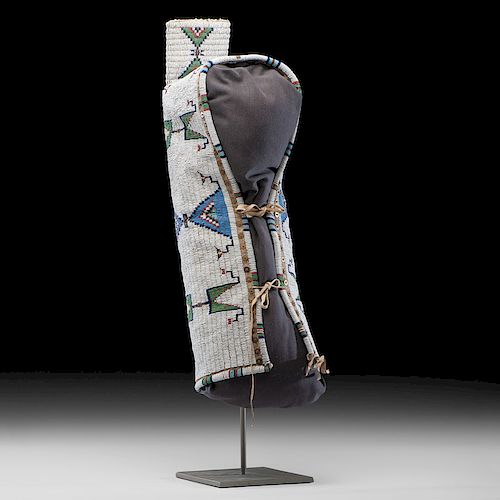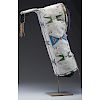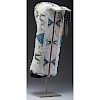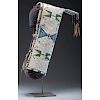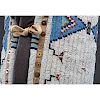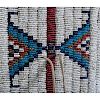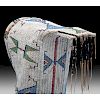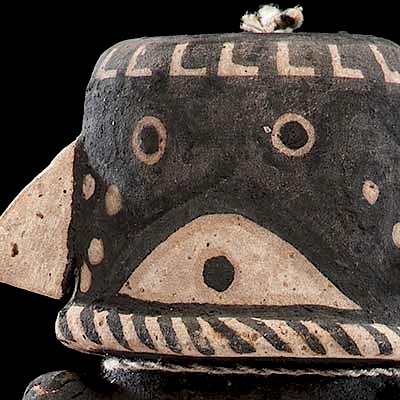Sioux Child's Beaded Hide Cradle
About Seller
6270 Este Ave.
Cincinnati , OH 45232
United States
With offices in Cincinnati, Cleveland and Denver, Cowan’s holds over 40 auctions each year, with annual sales exceeding $16M. We reach buyers around the globe, and take pride in our reputation for integrity, customer service and great results. A full-service house, Cowan’s Auctions specializes in Am...Read more
Two ways to bid:
- Leave a max absentee bid and the platform will bid on your behalf up to your maximum bid during the live auction.
- Bid live during the auction and your bids will be submitted real-time to the auctioneer.
Bid Increments
| Price | Bid Increment |
|---|---|
| $0 | $25 |
| $500 | $50 |
| $1,000 | $100 |
| $2,000 | $250 |
| $5,000 | $500 |
| $10,000 | $1,000 |
| $20,000 | $2,500 |
| $50,000 | $5,000 |
| $100,000 | $10,000 |
About Auction
Sep 21, 2018
Cowan's Fall American Indian and Western Art: Premier Auction features Hopi katsinas from the collection of Charles McNutt, Sr., a Pueblo Shield and award winning contemporary pottery from the Collection of William & Putzi Saunders and prehistoric artifacts from the Jan Sorgfrei Collection Cowan's Auctions dawnie@cowans.com
- Lot Description
sinew-sewn on thick hide; beaded using colors of red white-heart, pea green, dark blue, medium blue, light blue, white, and faceted brass; edges detailed with sequins and red white-heart beads; hood tab embellished with hide fringe and cobalt basket beads, overall length 25 in.
fourth quarter 19th century
Exhibited: The Smith-Zimmerman Museum, Lake County, SD.
Baby carriers entirely covered with beadwork first made their appearance among Plains Indians beginning in the latter half of the nineteenth century. Beginning with the reservation period, when the arts burgeoned, man beadwork artists provided income for their families by making traditional objects for local use, and for sale to outsiders as well. Artists also turned out quantities of objects, as custom required gifts for making special occasions, such as the birth of a child.
Elaborate baby carriers epitomize the adulation that Indians lavished on children. It is told that years ago, on the birth of a child to a prominent Lakota family, more than two dozen richly adorned baby carriers were gifted to the newborn! An engaging story is also told of how this baby carrier came into the hands of George Mueller, the first non-Indian owner. In the early 1900s, Mueller served as a teacher in one-room schools in the White River Valley, which courses nearby Rosebud and Pine Ridge Reservations of South Dakota. During his sojourn, Mueller became friends with an elderly Lakota woman known to us only as "White River Woman". As a parting gift for George, when he left to take a job in Custer, South Dakota, White River Woman presented him with this splendid baby carrier that she had made for a grandchild "who never arrived".
In his seminal work, Decorative Art of the Sioux Indians, Clark Wissler published crucial information for understanding the motifs seen in Lakota beadwork. From his interviews with Lakota beadworkers he explains that the women referred to complex patterns like the one on this baby carrier as "looking glass patterns" or "reflected patterns". Over time, however, the designs largely lost any original symbolism embodied therein. Wissler concludes, "The motif with the Indian worker is taken as entirely decorative, i.e. the designs are wrought to please the eye." It remains unknown to us any intentional and personal significant that the White River Woman imbued into the beadwork on this baby carrier. Nonetheless, her evident mastery of her people's arts remains salient.
Benson L. Lanford
March 1, 2002
Collected from the Rosebud Reservation by George Mueller, the present owner's great uncle. - Shipping Info
-
Buyers are required to pay for all packing, shipping and insurance charges. Overseas duty charges are the responsibility of the successful Bidder. Be aware that for larger and/or valuable items, shipping charges can be substantial. - If there is no shipping amount on listed your invoice, you will need to make arrangements to pick up or ship your purchase through an alternative shipping company. Our shipping department can be contacted at 513.871.1670 (ext. 219) or email shipping@cowans.com. - Shipping charges include insurance for your order while in transit. If you have private insurance we will adjust your charge to include only packing and shipping. - Please allow 14 – 21 days after payment to package and ship your purchase as carefully as possible.
-
- Buyer's Premium



 EUR
EUR CAD
CAD AUD
AUD GBP
GBP MXN
MXN HKD
HKD CNY
CNY MYR
MYR SEK
SEK SGD
SGD CHF
CHF THB
THB